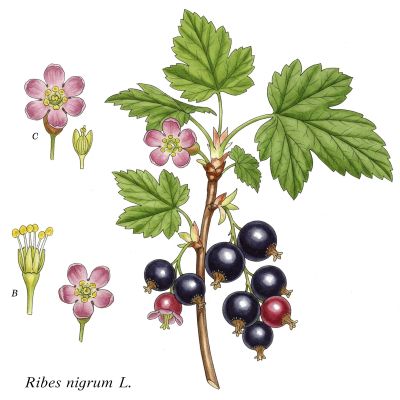Black Currant
- Description of Black Currant
- Habitat and Ecology of Black Currant
- Black Currant Raw Material
- Chemical Composition of Black Currant
- Action and Application of Black Currant
- Precautions for Black Currant Use
- Contraindications for Black Currant Use
- Black Currant Recipes
- Black Currant Cosmetics
- Black Currant Cuisine
Black Currant
Ribes nigrum L.
Family Grossulariaceae
Description of Black Currant
Black currant is a deciduous shrub, 1–2 m tall, with erect or spreading branches. Leaves are alternate, 3–5-lobed, 5–10 cm, dark green, with an aromatic scent. Flowers are small, greenish-white or pinkish, 5–8 mm, gathered in racemes (5–10 flowers). Fruits are round berries, 8–12 mm, black or dark purple, with a sour taste. Varieties: 'Titania', 'Ben Lomond', 'Black Pearl', 'Consort', 'Crusader'. Flowering in May–June, fruiting in July–August.
Habitat and Ecology of Black Currant
The origin of black currant is Europe and Northern Asia. It grows in forests, at forest edges, along water bodies, up to 1500 m above sea level. It is cultivated in Russia, Poland, Germany, Canada. It prefers loamy or sandy loam soils (pH 5.5–7.0), partial shade or sun, watering 10–15 l/bush once every 7–10 days. Propagated by cuttings, layering. Yield: 3–7 kg/bush. Care: pruning, nitrogen fertilization (10–15 g/m²), protection from anthracnose, aphids. Used in landscaping, for hedges, as a honey plant.
Black Currant Raw Material
Raw material: fruits (fructus Ribis nigri), leaves (folia Ribis nigri), buds (gemmae Ribis nigri). Fruits are harvested in July–August, dried at 40–50 °C (yield 15–20%). Leaves are harvested in June–July, dried at 40 °C (yield 15–20%). Buds are harvested in early spring, dried at 30–40 °C (yield 10–15%). Quality: fruits — black, without mold; leaves — green; buds — brown; moisture ≤12%. Store in airtight containers (fruits: 1 year; leaves: 1 year; buds: 1 year). Scent is aromatic (leaves, buds), taste is sour (fruits).
Chemical Composition of Black Currant
Fruits: water (85%), sugars (up to 10%), organic acids (citric, malic, up to 3%), pectins (up to 1.5%), vitamin C (up to 200 mg%), A, E, flavonoids, anthocyanins, minerals (K, Fe, Mn). Leaves: essential oil (up to 0.5%), flavonoids, tannins (up to 4%), vitamin C (up to 100 mg%). Buds: essential oil (up to 1%), flavonoids. Calorie content of fruits: 40–50 kcal/100 g (fresh), 200–250 kcal/100 g (dried).
Action and Application of Black Currant
Black currant has anti-inflammatory, diuretic, antioxidant, immunostimulating, and astringent effects. It is used for colds, avitaminosis, hypertension, anemia, kidney diseases, and skin inflammations. Fruits strengthen immunity, improve vision, and support vascular health. Leaves help with arthritis, dermatitis, and sore throats. Buds are used in aromatherapy, for stress relief. Fruit juice increases appetite and lowers fever.
Precautions for Black Currant Use
Consumption of >500 g/day of fresh or >100 g/day of dried fruits can cause diarrhea, stomach irritation. Store juice at 0–5 °C for no longer than 24 hours. Children under 3 years old should be given ≤50 g/day of fruits. Avoid combining with anticoagulants (enhancement of effect). Long-term use of leaf or bud infusions (>2 weeks) requires medical supervision. Wash fruits thoroughly due to pesticides.
Contraindications for Black Currant Use
Allergy to Grossulariaceae, gastritis with high acidity, exacerbated stomach ulcers, urolithiasis, anticoagulant therapy, pregnancy, lactation.
Black Currant Recipes
- Fruit infusion for colds. Pour 200 ml of boiling water over 20 g of dried fruits, infuse for 20 minutes, drink 50 ml 3 times a day for 7 days.
- Leaf decoction for arthritis. Boil 10 g of leaves in 200 ml of water for 10 minutes, drink 50 ml twice a day for 7 days.
- Compresses for dermatitis. Pour 100 ml of boiling water over 10 g of leaves, infuse for 20 minutes, apply for 15 minutes, twice a day for 5 days.
- Juice for anemia. Drink 50 ml of fruit juice twice a day for 7 days.
- Black Currant Syrup. Cook fresh black currants with sugar and water, then strain to make a concentrated syrup perfect for drinks or desserts.
- Black Currant and Apple Crumble. Combine black currants and chopped apples, top with a buttery oat crumble, and bake until bubbly.
Black Currant Cosmetics
Black currant is used for skin care.
- Mask for rejuvenation. 20 g of fruit pulp, 10 ml of honey, apply for 15 minutes, rinse, twice a week.
- Lotion for oily skin. 20 ml of fruit juice, 10 ml of water, wipe the skin, once a day.
- Mask for hydration. 20 g of pulp, 10 ml of yogurt, apply for 20 minutes, rinse, twice a week.
- Leaf infusion for acne. Pour 100 ml of boiling water over 10 g of leaves, infuse for 20 minutes, wipe the skin, twice a day.
- Black Currant Facial Toner. Mix black currant juice with witch hazel for a refreshing and antioxidant-rich toner.
Black Currant Cuisine
Fruits are used fresh, dried, in drinks, and desserts.
- Fruit Drink (Mors). 200 g fresh fruits, 1 L water, 50 g sugar, boil for 10 minutes, strain.
- Jam. 1 kg fruits, 800 g sugar, 200 ml water, cook for 30 minutes, store in jars.
- Sauce for desserts. 200 g fruits, 50 g sugar, cook for 15 minutes, mash.
- Smoothie. 200 g fruits, 100 ml yogurt, 10 g honey, blend.
- Black Currant Sorbet. Blend black currants with sugar and a little water, then freeze in an ice cream maker for a refreshing dessert.
- Black Currant Muffins. Fold fresh or frozen black currants into a muffin batter and bake until golden.
Tips: Store fresh fruits at 0–5 °C for up to 2 weeks, dried — for up to 1 year. Freeze for long-term storage.
Other properties of black currant
Used in ornamental landscaping, for hedges, as a honey plant.




